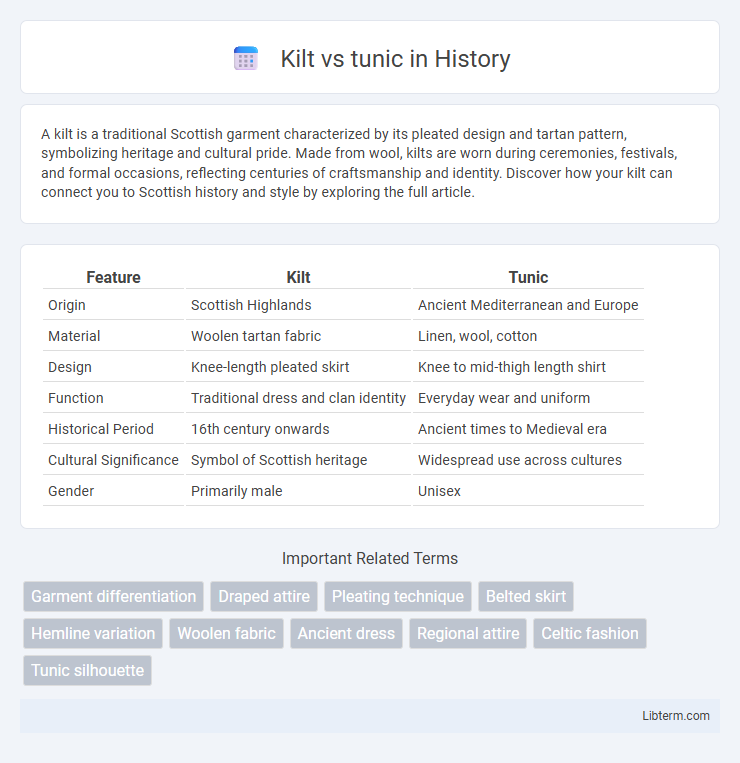A kilt is a traditional Scottish garment characterized by its pleated design and tartan pattern, symbolizing heritage and cultural pride. Made from wool, kilts are worn during ceremonies, festivals, and formal occasions, reflecting centuries of craftsmanship and identity. Discover how your kilt can connect you to Scottish history and style by exploring the full article.
Table of Comparison
| Feature | Kilt | Tunic |
|---|---|---|
| Origin | Scottish Highlands | Ancient Mediterranean and Europe |
| Material | Woolen tartan fabric | Linen, wool, cotton |
| Design | Knee-length pleated skirt | Knee to mid-thigh length shirt |
| Function | Traditional dress and clan identity | Everyday wear and uniform |
| Historical Period | 16th century onwards | Ancient times to Medieval era |
| Cultural Significance | Symbol of Scottish heritage | Widespread use across cultures |
| Gender | Primarily male | Unisex |
Historical Origins: Kilt vs. Tunic
The kilt originated in the Scottish Highlands during the 16th century as a garment made from wool tartan, symbolizing clan identity and Scottish heritage. The tunic, dating back to ancient civilizations such as Rome and Greece, served as a versatile garment worn by both men and women across Europe and the Middle East. While the kilt is primarily associated with Scottish culture and tradition, the tunic has a broader historical presence as a fundamental article of clothing in various cultures worldwide.
Cultural Significance and Symbolism
Kilts hold deep cultural significance as traditional Scottish garments symbolizing clan identity, heritage, and pride, often adorned with distinctive tartan patterns representing specific families or regions. Tunics, worn across various ancient civilizations including Roman, Greek, and early medieval societies, symbolize status, profession, and regional affiliation, often decorated to convey social rank or cultural affiliation. Both garments serve as powerful emblems of identity and tradition, reflecting the values and histories of their respective cultures.
Key Differences in Design and Structure
Kilts, traditionally associated with Scottish heritage, are knee-length skirts made of woolen tartan fabric with pleats at the back, designed to wrap around the waist and secured with straps or buckles. Tunics are loose-fitting garments extending from the shoulders to various lengths, often without pleats, crafted from a range of materials like linen or cotton, and worn as a single piece over the torso. The key structural difference lies in the kilt's fixed pleated, wrap-around design versus the tunic's simple, straight, and unpleated form that drapes over the body.
Materials and Fabric Choices
Kilts traditionally use heavyweight wool, prized for durability and insulation, making them ideal for outdoor wear and ceremonial use. Tunics feature a wider range of fabrics, including linen, cotton, silk, and blends, offering versatility for different climates and occasions. Wool kilts emphasize structured form and warmth, while tunics prioritize comfort and breathability through lighter materials.
Traditional Usage and Occasions
Kilts are traditionally worn in Scotland during formal events, Highland games, and cultural celebrations, symbolizing clan heritage and Scottish identity. Tunics have been used widely across various ancient and medieval cultures, often as everyday wear or military attire, adapted for practical use in different climates and social contexts. While kilts maintain strong ties to ceremonial occasions, tunics vary more broadly in style and function, reflecting diverse historical and cultural applications.
Regional Variations Across the World
Kilts, traditionally associated with Scottish culture, vary significantly from tunics, which are widespread across regions from the Mediterranean to Asia, reflecting distinct cultural origins and uses. Kilts are typically knee-length skirts made of tartan fabric symbolizing Scottish clans, while tunics are versatile, loose-fitting garments found in ancient European, Middle Eastern, and Asian attire, often extending to mid-thigh or longer. Regional variations highlight kilts' prominence in Celtic heritage, contrasting with tunics' broad adaptation in climates and ceremonial contexts worldwide.
Modern Interpretations and Fashion Trends
Modern interpretations of the kilt emphasize its cultural heritage while incorporating contemporary fabrics and patterns, making it popular in both formal and casual fashion. Tunics have evolved with experimental designs and bold prints, often seen in streetwear and high fashion runways, blending comfort with style. Both garments are celebrated for their versatility, merging traditional roots with modern aesthetics to appeal to diverse fashion audiences.
Practicality and Comfort Comparison
Kilts offer greater freedom of movement and breathability, making them highly practical for activities requiring agility or warm weather wear. Tunics, often made from heavier fabrics, provide more coverage and protection, suitable for cooler climates but can feel restrictive during prolonged physical exertion. Both garments balance comfort and functionality differently, with kilts excelling in ventilation and tunics offering layered warmth.
Notable Figures and Pop Culture Influence
Famous historical figures like Scottish clansmen and warriors popularized the kilt as a symbol of heritage and identity, while tunics were commonly worn by influential Roman leaders, medieval knights, and Renaissance artists, marking them as symbols of status and function. In modern pop culture, the kilt has been embraced by musicians such as the Red Hot Chili Peppers' Anthony Kiedis and movie characters in films like Braveheart, reinforcing its association with Scottish pride and rebellion. Tunics continue to influence contemporary fashion and film, featuring prominently in fantasy genres and historical dramas, underscoring their versatility and enduring appeal.
Preservation and Revival in Contemporary Times
The preservation of kilts and tunics has seen a significant resurgence in contemporary times through cultural festivals and fashion designers who incorporate traditional patterns and materials into modern apparel. Kilts, particularly in Scottish heritage, are preserved as symbols of clan identity, with efforts to maintain authentic tartan weaving techniques and ceremonial use. Tunics, widely found across various cultures, are being revived through global fashion trends that emphasize sustainable, handcrafted clothing reflecting historical craftsmanship.
Kilt Infographic

 libterm.com
libterm.com